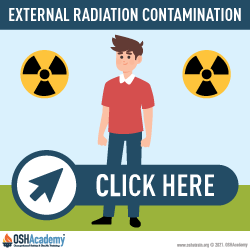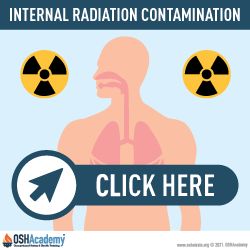Radiation Emergencies
Emergency services physicians and nurses will be among the first clinicians to see and treat radiation emergency victims. Clinicians of all specialties will be responsible for providing care and information to:
- patients admitted to the hospital
- patients presenting for follow-up care
- concerned individuals
- others with questions about health effects related to the emergency
PPE in Radiation Emergencies
In a radiation emergency, the choice of appropriate personal protective equipment (PPE) depends on:
- response role and specific tasks
- risk of contamination
PPE can protect against the following:
- external contamination
- External contamination occurs when radioactive material, in the form of dust, powder, or liquid, comes into contact with a person's skin, hair, or clothing. (Click the image to the right to view animation.)
- internal contamination
- Internal contamination occurs when people swallow or breathe in radioactive materials, or when radioactive materials enter the body through an open wound or are absorbed through the skin. (Click the image to the right to view animation.)
- other physical hazards (i.e., debris, fire/heat, or chemicals)
PPE cannot protect against high energy exposure, highly penetrating forms of ionizing radiation associated with most radiation emergencies.
Lead aprons worn in diagnostic radiology do not provide sufficient shielding against these kinds of radiation.
PPE should include a personal radiation dosimeter whenever there is concern about exposure to penetrating ionizing radiation.
- Direct-reading personal radiation dosimeters may be used to monitor radiation dose. They can help workers stay within recommended Dose Limits for Emergency Workers.
- Direct-reading dosimeters should be worn so that a worker can easily see the read-out and, if equipped, hear warning alarms.
Recommended respiratory protection includes a full-facepiece air-purifying respirator with a P-100 filter or High-Efficiency Particulate Air (HEPA) filter.
Other respiratory protective equipment (e.g., a simple surgical facemask, N-95 respirators), non-fit tested respirators, or ad hoc respiratory protection do not deliver appropriate or sufficient respiratory protection.
Environmental testing and hazard assessment by a safety professional can help identify hazards and risk levels and direct permissible PPE choices.
Knowledge Check Choose the best answer for the question.
1-8. During a radiation emergency, the choice of appropriate personal protective equipment (PPE) depends on what factor?
You forgot to answer the question!


